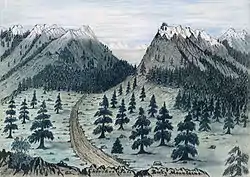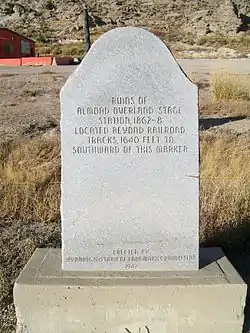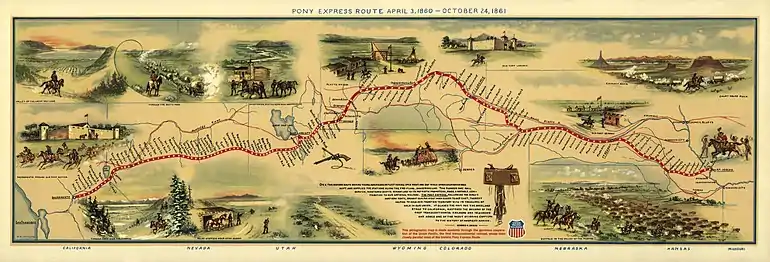Overland Trail
The Overland Trail (also known as the Overland Stage Line) was a stagecoach and wagon trail in the American West during the 19th century. While portions of the route had been used by explorers and trappers since the 1820s, the Overland Trail was most heavily used in the 1860s as a route alternative to the Oregon, California, and Mormon trails through central Wyoming. The Overland Trail was famously used by the Overland Stage Company owned by Ben Holladay to run mail and passengers to Salt Lake City, Utah, via stagecoaches in the early 1860s. Starting from Atchison, Kansas, the trail descended into Colorado before looping back up to southern Wyoming and rejoining the Oregon Trail at Fort Bridger. The stage line operated until 1869 when the completion of the First Transcontinental Railroad eliminated the need for mail service via Thais' stagecoach.
History
In 1857, the United States Post Office Department extended bids for mail service along what became known as the "southern route" from Memphis, Tennessee, to San Francisco, California, through New Mexico and Arizona. The contract was given to the Butterfield Overland Mail Company and service ran until the Civil War started in 1861. Wells Fargo was the primary lender to the company and took control when it suffered financial difficulties in 1859. After the southern route was disbanded, the Overland Mail Company moved its operations to the central line between Salt Lake City and Sacramento.
The Chorpenning contract was annulled in 1860 and was subsequently awarded to the Central Overland California and Pikes Peak Express Company (C.O.C and P.P Express), which ran stage lines between Missouri and Utah along the Oregon Trail. In 1860, the C.O.C and P.P Express started the Pony Express , which followed the Oregon and Mormon Trails to Salt Lake City and the Central Nevada Route to Sacramento. The Pony Express only lasted a year before the C.O.C and P.P Express went bankrupt and the assets were sold to Ben Holladay. In 1861, Holladay was awarded the Postal Department contract for overland mail service between the end of the western terminus of the railroad in Missouri and Kansas and Salt Lake City. Service from Utah to California was given to the Overland Mail Company and other stage lines.[1]
The start of the Civil War also forced the United States Army to move its regular soldiers from forts and outposts along the Oregon Trail to the east and replace them with volunteers. As a result, Native American raids on the trail intensified. The Army and Holladay wanted to find a safer route to the south. In 1851, Army Topographical Engineer Captain Howard Stansbury, returning east from an expedition to the Salt Lake Valley, described a route from Fort Bridger via the Bitter Creek valley and Laramie Plains to the North Platte River.[2] Stansbury's route was well known by local trappers and traders. General William Henry Ashley had crossed the Laramie Plains in 1825, John C. Fremont camped near Elk Mountain in 1843 and miners and trappers heading to California used the Cherokee Trail in the late 1840s. Based on these reports, the new trail was established from Atchison, Kansas, ascending the South Platte River and striking the Cherokee Trail though Wyoming to Fort Bridger. Mail service started along the Overland Stage Route on July 1, 1861. Holladay retained the mail contract on the route until 1866, when it was sold to Wells Fargo. Stage operations continued until 1869, when the completion of the Transcontinental Railroad made stage service unnecessary.
 |
| Trails |
|---|
Over time, increasing emigrant traffic and homesteading in the plains and shifting buffalo herds forced Native American tribes into southern Wyoming and northern Colorado, leading to conflicts on the Overland Trail, especially in the eastern portion along the South Platte River and in the western portion along the Laramie Plains. Attempts to force the Native Americans onto a reservation came to a head during the Colorado War in 1864. Camp Collins, near present-day Fort Collins, Colorado, and Fort Sanders and Fort Halleck in Wyoming were established to protect travelers against Sioux raids on the trail during the 1860s. Stagecoach stations and ranches along 150 miles (240 km) of the South Platte River were burned down by an army of Cheyenne, Arapaho, and Sioux in January and early February 1865. (See Battle of Julesburg.)
Route
Starting at the terminus of the railroad in Atchison, the Overland Trail paralleled the other emigrant trails on the Great Platte River Road along the North Platte River in Kansas and Nebraska. At Julesburg, Colorado, the trail splits from the others and continues along the South Platte River. Following the same general path that miners used during the Pike's Peak Gold Rush, the trail follows the South Platte through the present day towns of Sterling, Fort Morgan and to Latham, the last station on the South Platte. Located near the present day city of Greeley, Latham was an important stage stop and junction joining the Overland Trail and a short spur connecting the trail to Denver and the surrounding mining towns. From Latham the stage route crosses the South Platte to Laporte and strikes the well established Cherokee Trail going north into Wyoming. In 1862, the Fort Morgan Cut-Off was established between Fort Morgan and Denver saving three days and 40 miles (64 km) from the previous route and cutting off stations between Fort Morgan and Latham.
In Wyoming, the trail goes through the Laramie River Valley and skirts the northern side of Elk Mountain. Fort Halleck was established here in 1862 to protect travelers on the trail. Following the same path as the later transcontinental railroad and modern Interstate 80, the trail crosses the Red Desert and follows Bitter Creek through the present towns of Rock Springs, Point of Rocks, and Green River. From Green River the trail proceeds west to Blacks Fork, following it upstream to Granger where it joins the Emigrant Trails descending from South Pass and continues to Fort Bridger. From Fort Bridger the stage route follows the Mormon Trail the remainder of the way to Salt Lake City.
Remnants
Several modern highways follow the same route as the Overland Trail. Interstate 76 follows the South Platte River to Fort Morgan, Colorado, and U.S. Route 34 goes between Fort Morgan and Greeley. North of Fort Collins, U.S. Route 287 follows the path of the Overland Trail north to Laramie. West of Laramie the Overland Trail route was closely followed by the Union Pacific Railroad in 1869 and the Lincoln Highway and Interstate 80 in the 20th century.
Remains of stage stops are scattered throughout Wyoming and northern Colorado including well preserved buildings at Virginia Dale, Colorado and Point of Rocks, Wyoming. The trail is occasionally marked with markers and historical signs where the trail crosses a highway. Switchbacks on the route can be clearly seen when on highway 287, just north of the town of Laporte, Colorado, above the present day Forks Lumber company, and portions of the route just east of that spot are well preserved and easily seen (although they are crossing through private property).
Cabins from Camp Collins an army post and stop along the Overland Trail are located at the Heritage Center at the Fort Collins Museum and Discovery Science Center. Included is the oldest cabin of Fort Collins "Auntie" Stone, who provided food to Camp Collins post officers and a small hotel and resting spot for Overland Trail passengers.

Stage stops and notable landmarks
- Julesburg, Colorado
- North Platte River Crossing – Carbon County, Wyoming
- Bear River City, Wyoming
- Granger, Wyoming
- Point of Rocks, Wyoming
- Rattlesnake Station – Elmore County, Idaho
- Rock Creek Station and Stricker Homesite – Twin Falls County, Idaho
Overland Trail Museum

The city of Sterling, Colorado, operates the Overland Trail Museum, located on US route 6, just east of the South Platte River.[3] Opened in 1936, the museum contains dioramas and artifacts that relate to the history of the trail and to the city of Sterling.
See also
References
- Root, Frank Albert (1901). The overland stage to California: Personal reminiscences and authentic history of the great Overland Stage Line and Pony Express from the Missouri River to the Pacific Ocean. Crane & Co.
- Stansbury, Howard (1855). An expedition to the valley of the Great salt lake of Utah. Lippincott, Grambo, and Co. p. 233.
- City of Sterling Overland Trail Museum
Further reading
- LaSalle, Michael E. Emigrants on the Overland Trail: The Wagon Trains of 1848 (Kirksville: Truman State University Press, 2011. xx, 516 pp.
